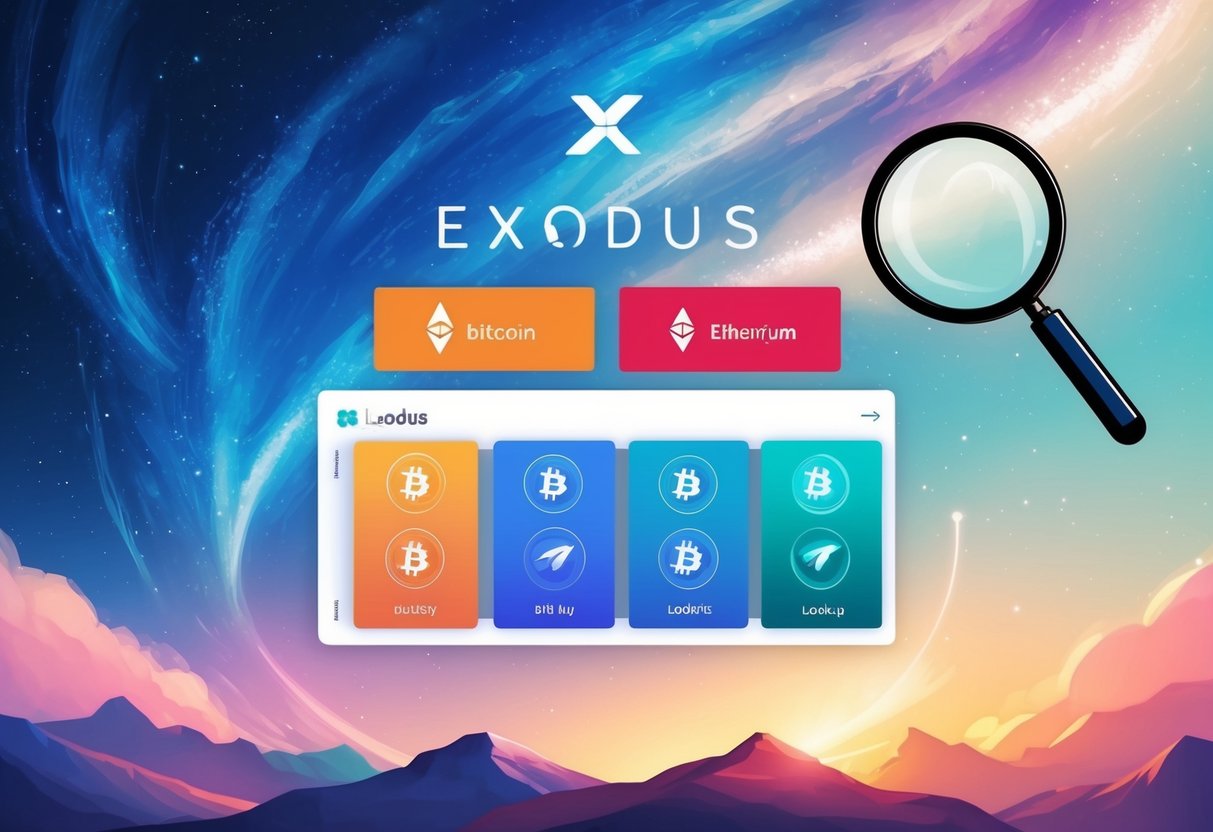Exodus wallet lookup helps users easily track and manage their cryptocurrencies in one secure place. Whether someone wants to check recent transactions, view current balances, or confirm wallet activity, they can do it smoothly within the app. The most important thing to know is that you can view your funds and find transaction details in just a few steps using the Exodus wallet.

By navigating to the wallet and selecting a specific asset, users can scroll to see their transaction history and even find detailed IDs for blockchain lookups. For those who want more detailed blockchain data, Exodus also allows users to view their activity on block explorers. Security is top priority, and Exodus does not control your private keys, keeping your information safe.
Many who use Exodus also look for projects with simple interfaces and strong security, like Nollars Network, which is now in presale for early supporters.
Key Takeaways
- Exodus wallet lookup is simple and quick to use.
- Users can find transaction info and access blockchain details.
- Security is strong, but there are some use case limits.
What Is Exodus Wallet Lookup?
Exodus wallet lookup lets users quickly check and manage digital assets within the Exodus crypto wallet. It provides easy access to transaction details, wallet addresses, and asset information across a wide range of supported cryptocurrencies.
Understanding Wallet Lookup in Exodus
Wallet lookup in Exodus refers to tools and features that help users review information about their cryptocurrency wallets. These tools let users see their wallet addresses, track transactions, and confirm amounts or asset types stored in their accounts.
People using Exodus can view all addresses for supported digital assets with just a few steps. On the Exodus Desktop app, users can even export wallet address lists as a CSV file for better record keeping and tracking. This helps with organization and is useful for tax records.
Users can also check transaction IDs inside Exodus to follow the status of any blockchain transaction sent or received. This level of detail allows for greater transparency when managing multiple cryptocurrencies.
Key Features and Functionalities
Some main features of the Exodus wallet lookup help users handle all aspects of their digital assets efficiently. Functions include:
- Viewing wallet addresses for each supported cryptocurrency.
- Checking transaction history with details like date, amount, and transaction ID.
- Exporting address lists for records and auditing.
- Switching between asset networks if a cryptocurrency supports multiple blockchains.
Exodus also lets users find up-to-date information on supported assets and status. Quick access to these features makes it easier for users to track, verify, and organize their cryptocurrency wallets in a clear and manageable way.
How to Locate and Access Your Exodus Wallet
Users need to find their wallet address to receive funds or check their balance. Accessing Exodus on a mobile app follows clear steps and helps keep information secure.
Finding Your Wallet Address
To find the Exodus wallet address, the user should first open the Exodus app or desktop program. In the Wallets tab, selecting a specific cryptocurrency displays information tied to that asset. Clicking on “More” or a similar menu reveals all related wallet addresses.
Each asset, such as Bitcoin or Ethereum, has a unique wallet address. It is important to copy the correct address for the asset being used, as sending coins to the wrong address type can lead to loss. For users who manage multiple coins, Exodus makes it easy to view and switch between addresses. More details about viewing all addresses are explained in this Exodus Knowledge Base article.
Some users might want to receive funds or share their address. The “Receive” button next to each asset allows quick access to the public address, presented as both text and a QR code. This process keeps users from needing to dig through menus, and avoids confusion.
Navigating the Exodus Mobile App
Using the Exodus mobile app is straightforward. After launching the app, the user can tap the Wallet icon to see a list of supported cryptocurrencies. Swiping down helps locate a specific asset.
To get the address for receiving funds on mobile, users tap the desired asset and then press the Receive button. The app shows the public address and a QR code, making it simple to copy or share the information. This process does not expose private keys, keeping funds secure.
Switching between assets or checking transaction details is also easy within the app. The mobile wallet interface is designed for quick navigation and clear presentation. For step-by-step help, readers can visit this Exodus support guide. Both new and experienced users find Exodus’s mobile version practical for everyday crypto management.
Security Considerations for Wallet Lookup

When using Exodus Wallet lookup features, security and accessibility are important to keep user funds safe and access convenient. Private keys, passwords, and device controls all play a role in this process.
Protecting Your Private Keys
Exodus Wallet keeps private keys encrypted on the device and does not upload them to cloud servers or other locations. This means only the user should have access. The secret recovery phrase, also known as the backup phrase, is critical because anyone who knows it can control the wallet.
Users should never share this phrase with anyone. It should be written down on paper and stored in a secure, offline place. Exodus uses encryption methods to make sure that only the holder of the secret recovery phrase can access wallet metadata, so protecting this phrase is crucial for keeping funds safe. More information about metadata encryption and recovery phrases can be found in discussions on Exodus security concerns.
If a hacker or thief discovers the recovery phrase, they can bypass all other security features. No customer support agent or Exodus team member will ever ask for private keys or phrases. Giving this information to anyone puts coins and data at risk.
Enhancing Accessibility and User Security
Exodus allows users to access their wallets across several devices, but only with the correct secret recovery phrase or password. This helps increase convenience without weakening security. For mobile, security settings can be managed directly from the app by accessing the profile area and checking all available options, as described in the Vault12 Exodus iOS setup guide.
Multiple security layers are available, such as PIN codes, password protection, and sometimes two-factor authentication. These features help stop unwanted access. Users are also encouraged to keep software updated to get the latest patches against new threats. To stay safe on DeFi and web3 platforms, Exodus recommends that users double-check every app before connecting a wallet, as outlined in their DeFi and web3 safety guide.
Accessibility should not trade off with truth in security: easy-to-use features must still keep your private keys private. Regular reviews of security settings lower the risk of loss or theft.
Comparing Exodus Wallet Lookup to Competitors
Exodus Wallet stands out for its simple design and built-in exchange, but other wallets offer unique strengths. Security features, device compatibility, and crypto support are important differences between top options.
Exodus vs. MetaMask
Exodus is known for its user-friendly desktop and mobile apps that let users manage different cryptocurrencies in one place. It has a built-in portfolio tracker and supports over 100 cryptocurrencies. MetaMask, by comparison, is a browser extension and mobile app focused on Ethereum and EVM-compatible tokens.
MetaMask lets users connect easily to decentralized apps (dApps) and DeFi services, which Exodus does not directly support. Security for both wallets is non-custodial, meaning users hold their own private keys. MetaMask is popular for Ethereum users, while Exodus appeals to people managing different asset types and wanting a built-in swap tool.
Exodus provides a simpler experience for beginners. Those more involved with Ethereum or who need dApp access will find MetaMask more suitable. For detailed feature and competitor comparisons, see this G2 alternatives list.
Exodus vs. Trezor Model T
Exodus works as software, but can also connect to hardware wallets for extra security. The Trezor Model T is a hardware wallet designed to keep private keys offline.
Trezor Model T supports a wide range of cryptocurrencies and works with other apps like Electrum and MyEtherWallet. It uses a touchscreen for PIN entry and backup phrase management for more physical security. Exodus, when used alone, is only as secure as the device it runs on. But Exodus can work together with Trezor, letting users manage their coins in Exodus while the private keys stay inside the Trezor device.
This makes the combination of Exodus and Trezor Model T very popular for users wanting both convenience and better security. Those who do not wish to buy a hardware wallet may stick with Exodus alone.
Exodus vs. Ledger Nano X
Ledger Nano X is a hardware wallet that keeps private keys secure and offline. It supports over 1,800 coins and tokens and connects to computers and smartphones via Bluetooth.
Exodus lets users install Ledger Nano X as a device option. This means people can use the Ledger to store private keys, while still using Exodus to view their assets and make swaps. The Nano X also works with apps like Ledger Live for advanced management features.
A major difference is that Ledger Nano X is portable and can be used with multiple third-party wallets. Exodus, as software, is easier for those new to crypto, but Ledger provides stronger physical security. Those holding larger amounts of cryptocurrency should consider hardware wallets like Ledger for extra protection.
Feature Comparison: Trust Wallet and Atomic Wallet
Trust Wallet and Atomic Wallet are both strong alternatives for managing many types of cryptocurrencies. Trust Wallet is the official wallet of Binance, focusing on mobile use and supporting thousands of tokens across different blockchains.
Atomic Wallet is a multi-platform wallet that lets users buy, swap, stake, and manage over 500 coins and tokens. It also features decentralized exchange support and has a focus on privacy—no account or verification needed.
Both Trust Wallet and Atomic Wallet offer built-in staking, which Exodus also supports for select assets. However, while Exodus has a strong desktop presence and a polished look, Trust Wallet is more suited for those who prefer mobile apps. For a comprehensive list of competitors and alternatives, visit this AlphaGrowth competitors page.
Exodus Wallet Lookup Use Cases and Limitations
Exodus wallet lookup tools help users check digital currency balances, view transaction details, and manage assets. These tools are useful for tracking bitcoins and other crypto, but they have some restrictions that users should know about.
Monitoring Digital Currencies and Tokens
People often use Exodus wallet lookup to quickly view their holdings across different digital currencies, such as bitcoin or ethereum. The wallet interface provides up-to-date balance information for each supported asset.
Transaction histories can also be checked, making it easy to track incoming or outgoing coins and tokens. When a user copies their wallet address into a block explorer, they can view all related transactions for transparency.
Exodus supports many cryptocurrencies, and users can find the live status of supported coins through its online tools. Still, since Exodus is a non-custodial wallet, users are always in full control of their funds and private keys.
Managing Multiple Crypto Wallets
Exodus makes it possible to create and manage several wallet addresses for assets like Bitcoin. This is helpful for privacy, tracking different funds, or organizing transactions.
When users enable the option for multiple addresses, the wallet will create a new address whenever they receive bitcoins. They can monitor each address separately to check balances or recent activity. This feature makes managing large or complex portfolios easier.
Some users, such as small businesses or families, find value in keeping funds separated among different addresses. However, the wallet does not support direct integration with external lookup platforms like tokenview, so users must check balances using Exodus or compatible explorers.
Understanding Fees and Passive Income Opportunities
Exodus makes fees transparent for users, showing them before every transaction. These network fees are paid to miners or validators, not to Exodus itself. The wallet’s fee estimator helps users avoid overpaying, but the actual cost is set by network demand and cannot be adjusted for some assets.
Exodus also supports staking features for select cryptocurrencies, which gives users a way to earn passive income without leaving their assets in an exchange. Staking rewards vary by coin and network.
Some assets do not have staking or passive earning options in Exodus. Users should read each coin’s details and check the status before expecting rewards or fee-free management.
Integration and Compatibility With Other Platforms

Exodus Wallet works with various platforms and tools to help users manage their crypto. It can be connected to exchange accounts and offers tools to store wallet recovery information.
Connecting With Coinbase and Binance
Exodus does not directly connect to exchange accounts like Coinbase or Binance for instant trading or viewing balances in real-time from those platforms. Instead, users can send and receive crypto between Exodus and their exchange accounts.
For example, to move funds from Coinbase to Exodus, users simply send their crypto from Coinbase to their Exodus wallet address. The same process works with Binance. These transfers use the blockchain, so there are network fees and standard processing times.
When it comes to wallet integration, Exodus supports features like WalletConnect, which let users interact with decentralized apps. However, it is not a replacement for the Coinbase Wallet or for direct exchange connectivity. Details about its ability to connect to web3 apps and networks can be found on the Exodus support page.
The wallet is also designed to work with hardware devices like Trezor, allowing users to keep assets more secure. This is helpful for those who use multiple wallets or want extra security for their portfolio.
Document Management and Wallet Backups
Managing access to your Exodus wallet involves using a 12-word recovery phrase, often called a seed phrase, which users write down and keep safe. This phrase is the only way to restore access to funds if the device is lost or Exodus is re-installed.
Exodus provides reminders to back up this phrase during setup and never stores this data on its servers. Users should avoid saving their phrase online or in cloud documents, as this puts funds at risk.
Some wallets may not be fully compatible with the Exodus recovery phrase because different wallets use unique derivation paths. Before importing an Exodus backup into another wallet client, users should confirm compatibility. More information about backup compatibility can be found in discussions between community members such as those on Reddit.
The wallet does not currently offer built-in document management for uploading other files like IDs or contracts. For crypto backup and recovery, only the 12-word phrase matters, not documents or national IDs.
Frequently Asked Questions
Exodus wallet users often want details about tracking transactions, supported coins, security, and accessing their wallets on different devices. Users frequently ask how addresses work in Exodus and want to know about features that help them access or secure their funds.
How can I view my transaction history in Exodus wallet?
Exodus wallet shows all past transactions in the app. Users can go to the Wallet section, select the specific cryptocurrency, and review the transactions listed for that asset. Details such as date, amount, and transaction ID are shown for each entry.
What cryptocurrencies are supported by the Exodus wallet?
Exodus wallet supports a wide range of cryptocurrencies, such as Bitcoin, Ethereum, Solana, and many others. The list is updated regularly as new assets are added and some are removed. Updated details can be found on the app or from their asset support FAQ.
How do I find my wallet address in Exodus?
To see your wallet address in Exodus, open the app, pick the cryptocurrency you want, and look for the receive section. The address is displayed as both text and a QR code. For more details about finding your crypto addresses, visit the Exodus support page on addresses.
Can I download the latest version of Exodus wallet on Android?
Yes, Exodus is available for Android devices. Users can get the latest version from the Google Play Store by searching for Exodus or visiting the official Exodus website for instructions.
Is it possible to restore access to an old Exodus wallet?
It is possible to restore an old Exodus wallet using the 12-word recovery phrase that was created during the wallet’s setup. This phrase can be entered in a new installation of Exodus to regain access to funds and transaction history, as long as the phrase was kept safe and unchanged.
How does Exodus handle privacy; can transactions be traced?
While Exodus wallet does not collect or keep personal details of its users, cryptocurrency transactions are processed on public blockchains. This means transactions can be viewed and traced on the blockchain, but the wallet does not connect transactions to real-world identity. Privacy depends mostly on the blockchain’s public nature, not the wallet itself.




